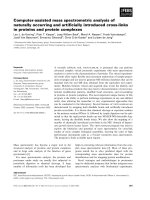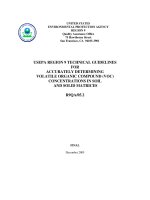Probabilistic Modeling in Bioinformatics and Medical Informatics potx
Bạn đang xem bản rút gọn của tài liệu. Xem và tải ngay bản đầy đủ của tài liệu tại đây (3.65 MB, 510 trang )
Advanced Information and Knowledge Processing
Also in this series
Gregoris Mentzas, Dimitris Apostolou, Andreas Abecker and Ron Young
Knowledge Asset Management
1-85233-583-1
Michalis Vazirgiannis, Maria Halkidi and Dimitrios Gunopulos
Uncertainty Handling and Quality Assessment in Data Mining
1-85233-655-2
Asuncio
´
nGo
´
mez-Pe
´
rez, Mariano Ferna
´
ndez-Lo
´
pez, Oscar Corcho
Ontological Engineering
1-85233-551-3
Arno Scharl (Ed.)
Environmental Online Communication
1-85233-783-4
Shichao Zhang, Chengqi Zhang and Xindong Wu
Knowledge Discovery in Multiple Databases
1-85233-703-6
Jason T.L. Wang, Mohammed J. Zaki, Hannu T.T. Toivonen and Dennis
Shasha (Eds)
Data Mining in Bioinformatics
1-85233-671-4
C.C. Ko, Ben M. Chen and Jianping Chen
Creating Web-based Laboratories
1-85233-837-7
K.C. Tan, E.F. Khor and T.H. Lee
Multiobjective Evolutionary Algorithms and Applications
1-85233-836-9
Manuel Gran
˜
a, Richard Duro, Alicia d’Anjou and Paul P. Wang (Eds)
Information Processing with Evolutionary Algorithms
1-85233-886-0
Dirk Husmeier, Richard Dybowski and
Stephen Roberts
(Eds)
Probabilistic
Modeling in
Bioinformatics and
Medical Informatics
With 218 Figures
Dirk Husmeier DiplPhys, MSc, PhD
Biomathematics and Statistics-BioSS, UK
Richard Dybowski BSc, MSc, PhD
InferSpace, UK
Stephen Roberts MA, DPhil, MIEEE, MIoP, CPhys
Oxford University, UK
Series Editors
Xindong Wu
Lakhmi Jain
British Library Cataloguing in Publication Data
Probabilistic modeling in bioinformatics and medical
informatics. — (Advanced information and knowledge
processing)
1. Bioinformatics — Statistical methods 2. Medical
informatics — Statistical methods
I. Husmeier, Dirk, 1964– II. Dybowski, Richard III. Roberts,
Stephen
570.2′85
ISBN 1852337788
Library of Congress Cataloging-in-Publication Data
Probabilistic modeling in bioinformatics and medical informatics / Dirk Husmeier,
Richard Dybowski, and Stephen Roberts (eds.).
p. cm. — (Advanced information and knowledge processing)
Includes bibliographical references and index.
ISBN 1-85233-778-8 (alk. paper)
1. Bioinformatics—Methodology. 2. Medical informatics—Methodology. 3. Bayesian
statistical decision theory. I. Husmeier, Dirk, 1964– II. Dybowski, Richard, 1951– III.
Roberts, Stephen, 1965– IV. Series.
QH324.2.P76 2004
572.8′0285—dc22 2004051826
Apart from any fair dealing for the purposes of research or private study, or criticism or review, as permitted under
the Copyright, Designs and Patents Act 1988, this publication may only be reproduced, stored or transmitted, in
any form or by any means, with the prior permission in writing of the publishers, or in the case of reprographic
reproduction in accordance with the terms of licences issued by the Copyright Licensing Agency. Enquiries con-
cerning reproduction outside those terms should be sent to the publishers.
AI&KP ISSN 1610-3947
ISBN 1-85233-778-8 Springer-Verlag London Berlin Heidelberg
Springer Science+Business Media
springeronline.com
© Springer-Verlag London Limited 2005
Printed and bound in the United States of America
The use of registered names, trademarks, etc. in this publication does not imply, even in the absence of a specific
statement, that such names are exempt from the relevant laws and regulations and therefore free for general use.
The publisher makes no representation, express or implied, with regard to the accuracy of the information con-
tained in this book and cannot accept any legal responsibility or liability for any errors or omissions that may be
made.
Typesetting: Electronic text files prepared by authors
34/3830-543210 Printed on acid-free paper SPIN 10961308
Preface
We are drowning in information,
but starved of knowledge.
– John Naisbitt, Megatrends
The turn of the millennium has been described as the dawn of a new scientific
revolution, which will have as great an impact on society as the industrial and
computer revolutions before. This revolution was heralded by a large-scale
DNA sequencing effort in July 1995, when the entire 1.8 million base pairs
of the genome of the bacterium Haemophilus influenzae was published – the
first of a free-living organism. Since then, the amount of DNA sequence data
in publicly accessible data bases has been growing exponentially, including a
working draft of the complete 3.3 billion base-pair DNA sequence of the entire
human genome, as pre-released by an international consortium of 16 institutes
on June 26, 2000.
Besides genomic sequences, new experimental technologies in molecu-
lar biology, like microarrays, have resulted in a rich abundance of further
data, related to the transcriptome, the spliceosome, the proteome, and the
metabolome. This explosion of the “omes” has led to a paradigm shift in
molecular biology. While pre-genomic biology followed a hypothesis-driven
reductionist approach, applying mainly qualitative methods to small, isolated
systems, modern post-genomic molecular biology takes a holistic, systems-
based approach, which is data-driven and increasingly relies on quantitative
methods. Consequently, in the last decade, the new scientific discipline of
bioinformatics has emerged in an attempt to interpret the increasing amount
of molecular biological data. The problems faced are essentially statistical,
due to the inherent complexity and stochasticity of biological systems, the
random processes intrinsic to evolution, and the unavoidable error-proneness
and variability of measurements in large-scale experimental procedures.
vi Preface
Since we lack a comprehensive theory of life’s organization at the molecular
level, our task is to learn the theory by induction, that is, to extract patterns
from large amounts of noisy data through a process of statistical inference
basedonmodelfittingandlearningfromexamples.
Medical informatics is the study, development, and implementation of al-
gorithms and systems to improve communication, understanding, and man-
agement of medical knowledge and data. It is a multi-disciplinary science
at the junction of medicine, mathematics, logic, and information technology,
which exists to improve the quality of health care.
In the 1970s, only a few computer-based systems were integrated with hos-
pital information. Today, computerized medical-record systems are the norm
within the developed countries. These systems enable fast retrieval of patient
data; however, for many years, there has been interest in providing additional
decision support through the introduction of knowledge-based systems and
statistical systems.
A problem with most of the early clinically-oriented knowledge-based sys-
tems was the adoption of ad hoc rules of inference, such as the use of certainty
factors by MYCIN. Another problem was the so-called knowledge-acquisition
bottleneck, which referred to the time-consuming process of eliciting knowl-
edge from domain experts. The renaissance in neural computation in the
1980s provided a purely data-based approach to probabilistic decision sup-
port, which circumvented the need for knowledge acquisition and augmented
the repertoire of traditional statistical techniques for creating probabilistic
models.
The 1990s saw the maturity of Bayesian networks. These networks pro-
vide a sound probabilistic framework for the development of medical decision-
support systems from knowledge, from data, or from a combination of the two;
consequently, they have become the focal point for many research groups con-
cerned with medical informatics.
As far as the methodology is concerned, the focus in this book is on proba-
bilistic graphical models and Bayesian networks. Many of the earlier methods
of data analysis, both in bioinformatics and in medical informatics, were quite
ad hoc. In recent years, however, substantial progress has been made in our
understanding of and experience with probabilistic modelling. Inference, de-
cision making, and hypothesis testing can all be achieved if we have access to
conditional probabilities. In real-world scenarios, however, it may not be clear
what the conditional relationships are between variables that are connected in
some way. Bayesian networks are a mixture of graph theory and probability
theory and offer an elegant formalism in which problems can be portrayed
and conditional relationships evaluated. Graph theory provides a framework
to represent complex structures of highly-interacting sets of variables. Proba-
bility theory provides a method to infer these structures from observations or
measurements in the presence of noise and uncertainty. This method allows
a system of interacting quantities to be visualized as being composed of sim-
Preface vii
pler subsystems, which improves model transparency and facilitates system
interpretation and comprehension.
Many problems in computational molecular biology, bioinformatics, and
medical informatics can be treated as particular instances of the general prob-
lem of learning Bayesian networks from data, including such diverse problems
as DNA sequence alignment, phylogenetic analysis, reverse engineering of ge-
netic networks, respiration analysis, Brain-Computer Interfacing and human
sleep-stage classification as well as drug discovery.
Organization of This Book
The first part of this book provides a brief yet self-contained introduction to
the methodology of Bayesian networks. The following parts demonstrate how
these methods are applied in bioinformatics and medical informatics.
This book is by no means comprehensive. All three fields – the methodol-
ogy of probabilistic modeling, bioinformatics, and medical informatics – are
evolving very quickly. The text should therefore be seen as an introduction,
offering both elementary tutorials as well as more advanced applications and
case studies.
The first part introduces the methodology of statistical inference and prob-
abilistic modelling. Chapter 1 compares the two principle paradigms of statis-
tical inference: the frequentist versus the Bayesian approach. Chapter 2 pro-
vides a brief introduction to learning Bayesian networks from data. Chapter 3
interprets the methodology of feed-forward neural networks in a probabilistic
framework.
The second part describes how probabilistic modelling is applied to bioin-
formatics. Chapter 4 provides a self-contained introduction to molecular phy-
logenetic analysis, based on DNA sequence alignments, and it discusses the
advantages of a probabilistic approach over earlier algorithmic methods. Chap-
ter 5 describes how the probabilistic phylogenetic methods of Chapter 4 can
be applied to detect interspecific recombination between bacteria and viruses
from DNA sequence alignments. Chapter 6 generalizes and extends the stan-
dard phylogenetic methods for DNA so as to apply them to RNA sequence
alignments. Chapter 7 introduces the reader to microarrays and gene expres-
sion data and provides an overview of standard statistical pre-processing pro-
cedures for image processing and data normalization. Chapters 8 and 9 address
the challenging task of reverse-engineering genetic networks from microarray
gene expression data using dynamical Bayesian networks and state-space mod-
els.
The third part provides examples of how probabilistic models are applied
in medical informatics.
Chapter 10 illustrates the wide range of techniques that can be used to
develop probabilistic models for medical informatics, which include logistic
regression, neural networks, Bayesian networks, and class-probability trees.
viii Preface
The examples are supported with relevant theory, and the chapter emphasizes
the Bayesian approach to probabilistic modeling.
Chapter 11 discusses Bayesian models of groups of individuals who may
have taken several drug doses at various times throughout the course of a
clinical trial. The Bayesian approach helps the derivation of predictive distri-
butions that contribute to the optimization of treatments for different target
populations.
Variable selection is a common problem in regression, including neural-
network development. Chapter 12 demonstrates how Automatic Relevance
Determination, a Bayesian technique, successfully dealt with this problem for
the diagnosis of heart arrhythmia and the prognosis of lupus.
The development of a classifier is usually preceded by some form of data
preprocessing. In the Bayesian framework, the preprocessing stage and the
classifier-development stage are handled separately; however, Chapter 13 in-
troduces an approach that combines the two in a Bayesian setting. The ap-
proach is applied to the classification of electroencephalogram data.
There is growing interest in the application of the variational method to
model development, and Chapter 14 discusses the application of this emerging
technique to the development of hidden Markov models for biosignal analysis.
Chapter 15 describes the Treat decision-support system for the selection
of appropriate antibiotic therapy, a common problem in clinical microbiol-
ogy. Bayesian networks proved to be particularly effective at modelling this
problem task.
The medical-informatics part of the book ends with Chapter 16, a descrip-
tion of several software packages for model development. The chapter includes
example codes to illustrate how some of these packages can be used.
Finally, an appendix explains the conventions and notation used through-
out the book.
Intended Audience
The book has been written for researchers and students in statistics, machine
learning, and the biological sciences. While the chapters in Parts II and III
describe applications at the level of current cutting-edge research, the chapters
in Part I provide a more general introduction to the methodology for the
benefit of students and researchers from the biological sciences.
Chapters 1, 2, 4, 5, and 8 are based on a series of lectures given at the
Statistics Department of Dortmund University (Germany) between 2001 and
2003, at Indiana University School of Medicine (USA) in July 2002, and at
the “International School on Computational Biology”, in Le Havre (France)
in October 2002.
Preface ix
Website
The website
/>∼parg/pmbmi.html
complements this book. The site contains links to relevant software, data,
discussion groups, and other useful sites. It also contains colored versions of
some of the figures within this book.
Acknowledgments
This book was put together with the generous support of many people.
Stephen Roberts would like to thank Peter Sykacek, Iead Rezek and
Richard Everson for their help towards this book. Particular thanks, with
much love, go to Clare Waterstone.
Richard Dybowski expresses his thanks to his parents, Victoria and Henry,
for their unfailing support of his endeavors, and to Wray Buntine, Paulo Lis-
boa, Ian Nabney, and Peter Weller for critical feedback on Chapters 3, 10,
and 16.
Dirk Husmeier is most grateful to David Allcroft, Lynn Broadfoot, Thorsten
Forster, Vivek Gowri-Shankar, Isabelle Grimmenstein, Marco Grzegorczyk,
Anja von Heydebreck, Florian Markowetz, Jochen Maydt, Magnus Rattray,
Jill Sales, Philip Smith, Wolfgang Urfer, and Joanna Wood for critical feed-
back on and proofreading of Chapters 1, 2, 4, 5, and 8. He would also like to
express his gratitude to his parents, Gerhild and Dieter; if it had not been for
their support in earlier years, this book would never have been written. His
special thanks, with love, go to Ulli for her support and tolerance of the extra
workload involved with the preparation of this book.
Edinburgh, London, Oxford Dirk Husmeier
UK Richard Dybowski
July 2003 Stephen Roberts
Contents
Part I Probabilistic Modeling
1 A Leisurely Look at Statistical Inference
Dirk Husmeier 3
1.1 Preliminaries 3
1.2 TheClassicalorFrequentistApproach 5
1.3 TheBayesianApproach 10
1.4 Comparison 12
References 15
2 Introduction to Learning Bayesian Networks from Data
Dirk Husmeier 17
2.1 IntroductiontoBayesianNetworks 17
2.1.1 TheStructureof a Bayesian Network 17
2.1.2 TheParametersofaBayesianNetwork 25
2.2 Learning Bayesian Networks from Complete Data 25
2.2.1 TheBasicLearning Paradigm 25
2.2.2 MarkovChainMonteCarlo(MCMC) 28
2.2.3 EquivalenceClasses 35
2.2.4 Causality 38
2.3 Learning Bayesian Networks from Incomplete Data 41
2.3.1 Introduction 41
2.3.2 Evidence Approximation and Bayesian Information
Criterion 41
2.3.3 TheEMAlgorithm 43
2.3.4 HiddenMarkovModels 44
2.3.5 Applicationofthe EMAlgorithm toHMMs 49
2.3.6 Applying the EM Algorithm to More Complex Bayesian
Networks with Hidden States 52
2.3.7 ReversibleJump MCMC 54
2.4 Summary 55
xii Contents
References 55
3 A Casual View of Multi-Layer Perceptrons as Probability
Models
Richard Dybowski 59
3.1 ABriefHistory 59
3.1.1 TheMcCulloch-Pitts Neuron 59
3.1.2 TheSingle-LayerPerceptron 60
3.1.3 Enterthe Multi-LayerPerceptron 62
3.1.4 A Statistical Perspective 63
3.2 Regression 63
3.2.1 MaximumLikelihoodEstimation 65
3.3 From Regression to Probabilistic Classification 65
3.3.1 Multi-LayerPerceptrons 67
3.4 Training a Multi-LayerPerceptron 69
3.4.1 The Error Back-Propagation Algorithm 70
3.4.2 AlternativeTrainingStrategies 73
3.5 SomePracticalConsiderations 73
3.5.1 Over-Fitting 74
3.5.2 LocalMinima 75
3.5.3 NumberofHidden Nodes 77
3.5.4 PreprocessingTechniques 77
3.5.5 Training Sets 78
3.6 FurtherReading 78
References 79
Part II Bioinformatics
4 Introduction to Statistical Phylogenetics
Dirk Husmeier 83
4.1 MotivationandBackgroundonPhylogeneticTrees 84
4.2 DistanceandClustering Methods 90
4.2.1 EvolutionaryDistances 90
4.2.2 ANaiveClusteringAlgorithm:UPGMA 93
4.2.3 An Improved Clustering Algorithm: Neighbour Joining . . 96
4.2.4 ShortcomingsofDistance andClusteringMethods 98
4.3 Parsimony 100
4.3.1 Introduction 100
4.3.2 Objectionto Parsimony 104
4.4 LikelihoodMethods 104
4.4.1 A Mathematical Model of Nucleotide Substitution 104
4.4.2 Details of the Mathematical Model of Nucleotide
Substitution 106
4.4.3 LikelihoodofaPhylogeneticTree 111
4.4.4 AComparisonwith Parsimony 118
Contents xiii
4.4.5 MaximumLikelihood 120
4.4.6 Bootstrapping 127
4.4.7 BayesianInference 130
4.4.8 Gaps 135
4.4.9 Rate Heterogeneity 136
4.4.10 ProteinandRNA Sequences 138
4.4.11 A Non-homogeneous and Non-stationary Markov Model
of Nucleotide Substitution 139
4.5 Summary 141
References 142
5 Detecting Recombination in DNA Sequence Alignments
Dirk Husmeier, Frank Wright 147
5.1 Introduction 147
5.2 RecombinationinBacteria andViruses 148
5.3 PhylogeneticNetworks 148
5.4 MaximumChi-squared 152
5.5 PLATO 156
5.6 TOPAL 159
5.7 Probabilistic Divergence Method (PDM) 162
5.8 EmpiricalComparisonI 167
5.9 RECPARS 170
5.10 CombiningPhylogeneticTreeswith HMMs 171
5.10.1 Introduction 171
5.10.2 MaximumLikelihood 175
5.10.3 BayesianApproach 176
5.10.4 Shortcomingsofthe HMM Approach 180
5.11 EmpiricalComparisonII 181
5.11.1 SimulatedRecombination 181
5.11.2 GeneConversionin Maize 184
5.11.3 Recombination in Neisseria 184
5.12 Conclusion 187
5.13 Software 188
References 188
6 RNA-Based Phylogenetic Methods
Magnus Rattray, Paul G. Higgs 191
6.1 Introduction 191
6.2 RNAStructure 193
6.3 Substitution Processes in RNA Helices 196
6.4 AnApplication:Mammalian Phylogeny 201
6.5 Conclusion 207
References 208
xiv Contents
7 Statistical Methods in Microarray Gene Expression Data
Analysis
Claus-Dieter Mayer, Chris A. Glasbey 211
7.1 Introduction 211
7.1.1 GeneExpressionin aNutshell 211
7.1.2 MicroarrayTechnologies 212
7.2 ImageAnalysis 214
7.2.1 Image Enhancement 215
7.2.2 Gridding 216
7.2.3 Estimators of Intensities 216
7.3 Transformation 218
7.4 Normalization 222
7.4.1 Explorative Analysis and Flagging of Data Points 222
7.4.2 LinearModelsandExperimental Design 225
7.4.3 Non-linearMethods 227
7.4.4 Normalization of One-channel Data 228
7.5 DifferentialExpression 228
7.5.1 One-slideApproaches 228
7.5.2 UsingReplicatedExperiments 229
7.5.3 MultipleTesting 232
7.6 FurtherReading 234
References 235
8 Inferring Genetic Regulatory Networks from Microarray
Experiments with Bayesian Networks
Dirk Husmeier 239
8.1 Introduction 240
8.2 ABriefRevision of BayesianNetworks 241
8.3 Learning Local Structures and Subnetworks 244
8.4 Applicationtothe YeastCellCycle 247
8.4.1 BiologicalFindings 248
8.5 Shortcomings of Static Bayesian Networks 251
8.6 DynamicBayesianNetworks 252
8.7 AccuracyofInference 252
8.8 EvaluationonSyntheticData 253
8.9 Evaluation on Realistic Data 257
8.10 Discussion 263
References 265
9 Modeling Genetic Regulatory Networks using Gene
Expression Profiling and State-Space Models
Claudia Rangel, John Angus, Zoubin Ghahramani, David L. Wild 269
9.1 Introduction 269
9.2 State-Space Models (Linear Dynamical Systems) 272
9.2.1 State-Space Model with Inputs 272
Contents xv
9.2.2 EM Applied to SSM with Inputs 274
9.2.3 KalmanSmoothing 275
9.3 TheSSMModelforGeneExpression 277
9.3.1 StructuralPropertiesoftheModel 277
9.3.2 Identifiability and Stability Issues 278
9.4 ModelSelectionby Bootstrapping 281
9.4.1 Objectives 281
9.4.2 TheBootstrapProcedure 281
9.5 Experiments with Simulated Data 283
9.5.1 ModelDefinition 283
9.5.2 ReconstructingtheOriginal Network 283
9.5.3 Results 283
9.6 Results from Experimental Data 288
9.7 Conclusions 289
References 291
Part III Medical Informatics
10 An Anthology of Probabilistic Models for Medical
Informatics
Richard Dybowski, Stephen Roberts 297
10.1 Probabilities in Medicine 297
10.2 Desiderata for Probability Models 297
10.3 Bayesian Statistics 298
10.3.1 ParameterAveragingandModelAveraging 299
10.3.2 Computations 300
10.4 Logistic Regression 301
10.5 Bayesian Logistic Regression 302
10.5.1 GibbsSampling and GLIB 304
10.5.2 HierarchicalModels 306
10.6 NeuralNetworks 307
10.6.1 Multi-LayerPerceptrons 307
10.6.2 Radial-Basis-Function Neural Networks 308
10.6.3 “Probabilistic Neural Networks” 309
10.6.4 MissingData 310
10.7 BayesianNeuralTechniques 311
10.7.1 ModeratedOutput 311
10.7.2 Hyperparameters 312
10.7.3 Committees 313
10.7.4 FullBayesian Models 314
10.8 The Na¨ıveBayes Model 316
10.9 BayesianNetworks 317
10.9.1 Probabilistic Inference over BNs 318
10.9.2 SigmoidalBeliefNetworks 321
xvi Contents
10.9.3 Construction of BNs: Probabilities 321
10.9.4 ConstructionofBNs: Structures 322
10.9.5 MissingData 322
10.10 Class-Probability Trees 323
10.10.1 MissingData 324
10.10.2 Bayesian Tree Induction 325
10.11 Probabilistic Models for Detection 326
10.11.1 DataConditioning 327
10.11.2 Detection, Segmentation and Decisions 330
10.11.3 ClusterAnalysis 331
10.11.4 HiddenMarkovModels 335
10.11.5 Novelty Detection 338
References 338
11 Bayesian Analysis of Population
Pharmacokinetic/Pharmacodynamic Models
David J. Lunn 351
11.1 Introduction 351
11.2 DeterministicModels 352
11.2.1 Pharmacokinetics 352
11.2.2 Pharmacodynamics 359
11.3 StochasticModel 360
11.3.1 Structure 360
11.3.2 Priors 363
11.3.3 ParameterizationIssues 364
11.3.4 Analysis 365
11.3.5 Prediction 366
11.4 Implementation 367
11.4.1 PKBugs 367
11.4.2 WinBUGSDifferentialInterface 368
References 369
12 Assessing the Effectiveness of Bayesian Feature Selection
Ian T. Nabney, David J. Evans, Yann Brul´e, Caroline Gordon 371
12.1 Introduction 371
12.2 BayesianFeature Selection 372
12.2.1 BayesianTechniquesforNeuralNetworks 372
12.2.2 AutomaticRelevanceDetermination 374
12.3 ARDinArrhythmiaClassification 375
12.3.1 ClinicalContext 375
12.3.2 BenchmarkingClassificationModels 376
12.3.3 Variable Selection 379
12.3.4 Conclusions 380
12.4 ARD in Lupus Diagnosis 381
12.4.1 ClinicalContext 381
Contents xvii
12.4.2 LinearMethodsforVariable Selection 383
12.4.3 PrognosiswithNon-linear Models 383
12.4.4 BayesianVariable Selection 385
12.4.5 Conclusions 386
12.5 Conclusions 387
References 388
13 Bayes Consistent Classification of EEG Data by
Approximate Marginalization
Peter Sykacek, Iead Rezek, and Stephen Roberts 391
13.1 Introduction 391
13.2 Bayesian Lattice Filter 393
13.3 SpatialFusion 396
13.4 Spatio-temporalFusion 400
13.4.1 ASimpleDAG Structure 401
13.4.2 ALikelihoodFunctionfor SequenceModels 402
13.4.3 AnAugmentedDAG forMCMCSampling 403
13.4.4 SpecifyingPriors 404
13.4.5 MCMC Updates of Coefficients and Latent Variables . . . 405
13.4.6 Gibbs Updates for Hidden States and Class Labels 407
13.4.7 ApproximateUpdatesofthe LatentFeature Space 408
13.4.8 Algorithms 409
13.5 Experiments 411
13.5.1 Data 412
13.5.2 ClassificationResults 413
13.6 Conclusion 415
References 416
14 Ensemble Hidden Markov Models with Extended
Observation Densities for Biosignal Analysis
Iead Rezek, Stephen Roberts 419
14.1 Introduction 419
14.2 PrinciplesofVariationalLearning 421
14.3 Variational Learning ofHiddenMarkov Models 423
14.3.1 LearningtheHMM HiddenStateSequence 425
14.3.2 LearningHMMParameters 426
14.3.3 HMMObservationModels 427
14.3.4 Estimation 431
14.4 Experiments 435
14.4.1 SleepEEGwith Arousal 435
14.4.2 Whole-NightSleep EEG 435
14.4.3 PeriodicRespiration 436
14.4.4 HeartbeatIntervals 437
14.4.5 Segmentation of Cognitive Tasks 439
14.5 Conclusion 440
xviii Contents
A ModelFreeUpdateEquations 442
B Derivation ofthe Baum-WelchRecursions 443
C CompleteKL Divergences 445
C.1 NegativeEntropy 446
C.2 KLDivergences 446
C.3 GaussianObservationHMM 447
C.4 PoissonObservation HMM 448
C.5 LinearObservationModelHMM 448
References 449
15 A Probabilistic Network for Fusion of Data and Knowledge
in Clinical Microbiology
Steen Andreassen, Leonard Leibovici, Mical Paul, Anders D. Nielsen,
Alina Zalounina, Leif E. Kristensen, Karsten Falborg, Brian
Kristensen, Uwe Frank, Henrik C. Schønheyder 451
15.1 Introduction 451
15.2 InstitutionofAntibioticTherapy 453
15.3 Calculation of Probabilities for Severity of Sepsis, Site of
Infection,andPathogens 454
15.3.1 PatientExample(Part1) 454
15.3.2 Fusion of Data and Knowledge for Calculation of
Probabilities for Sepsis and Pathogens 456
15.4 CalculationofCoverage and TreatmentAdvice 461
15.4.1 PatientExample(Part2) 461
15.4.2 Fusion of Data and Knowledge for Calculation of
CoverageandTreatmentAdvice 466
15.5 Calibration Databases 467
15.6 ClinicalTesting ofDecision-supportSystems 468
15.7 TestResults 468
15.8 Discussion 469
References 470
16 Software for Probability Models in Medical Informatics
Richard Dybowski 473
16.1 Introduction 473
16.2 Open-sourceSoftware 474
16.3 Logistic Regression Models 474
16.3.1 S-PlusandR 475
16.3.2 BUGS 476
16.4 NeuralNetworks 477
16.4.1 Netlab 477
16.4.2 TheStuttgartNeural NetworkSimulator 478
16.5 BayesianNetworks 478
16.5.1 HuginandNetica 481
16.5.2 TheBayesNetToolbox 481
Contents xix
16.5.3 TheOpenBayesInitiative 483
16.5.4 The Probabilistic Networks Library 483
16.5.5 ThegRProject 484
16.5.6 TheVIBESProject 484
16.6 Class-probability trees 484
16.7 HiddenMarkovModels 485
16.7.1 HiddenMarkovModelToolboxforMatlab 486
References 487
A Appendix: Conventions and Notation
491
Index 495
Part I
Probabilistic Modeling
1
A Leisurely Look at Statistical Inference
Dirk Husmeier
Biomathematics and Statistics Scotland (BioSS)
JCMB, The King’s Buildings, Edinburgh EH9 3JZ, UK
Summary. Statistical inference is the basic toolkit used throughout the whole
book. This chapter is intended to offer a short, rather informal introduction to
this topic and to compare its two principled paradigms: the frequentist and the
Bayesian approach. Mathematical rigour is abandoned in favour of a verbal, more
illustrative exposition of this subject, and throughout this chapter the focus will be
on concepts rather than details, omitting all proofs and regularity conditions. The
main target audience is students and researchers in biology and computer science,
who aim to obtain a basic understanding of statistical inference without having to
digest rigorous mathematical theory.
1.1 Preliminaries
This section will briefly revise Bayes’ rule and the concept of conditional
probabilities. For a rigorous mathematical treatment, consult a textbook on
probability theory.
Consider the Venn diagram of Figure 1.1, where, for example, G represents
the event that a hypothetical oncogene (a gene implicated in the formation of
cancer) is over-expressed, while C represents the event that a person suffers
from a tumour.
The conditional probabilities are defined as
P (G|C)=
P (G, C)
P (C)
(1.1)
P (C|G)=
P (G, C)
P (G)
(1.2)
where P (G, C) is the joint probability that a person suffers from cancer and
shows an over-expression of the indicator gene, while P (G)andP (C)arethe
marginal probabilities of contracting cancer or showing an over-expression of
the indicator gene, respectively.
4 Dirk Husmeier
C
G
Ω
C
G
Fig. 1.1. Illustration of Bayes’ rule. See text for details.
The first conditional probability, P(G|C), is the probability that the onco-
gene of interest is over-expressed given that its carrier suffers from cancer. The
estimation of this probability is, in principle, straightforward: just determine
the fraction of cancer patients whose indicator gene is over-expressed, and
approximate the probability by the relative frequency, by the law of large
numbers (see, for instance, [9]).
For diagnostic purposes more interesting is the second conditional prob-
ability, P (C|G), which predicts the probability that a person will contract
cancer given that their indicator oncogene is over-expressed. A direct deter-
mination of this probability might be difficult. However, solving for P (G, C)
in (1.1) and (1.2),
P (G, C)=P (G|C)P (C)=P (C|G)P (G) (1.3)
and then solving for P (C|G)gives:
P (C|G)=
P (G|C)P (C)
P (G)
(1.4)
Equation (1.4) is known as Bayes’ rule, which allows expressing a conditional
probability of interest in terms of the complementary conditional probability
and two marginal probabilities. Note that, in our example, the latter are eas-
ily available from global statistics. Consequently, the diagnostic conditional
probability P(C|G) can be computed without having to be determined ex-
plicitly.
Now, the objective of inference is to learn or infer these probabilities from
a set of training data, D, where the training data result from a series of
observations or measurements. Suppose you toss a coin or a thumbnail. There
1 A Leisurely Look at Statistical Inference 5
Heads Tails
Probability
θ
1−θ
Data
N tosses, k observations of "heads"
0 0.5 1
Fig. 1.2. Thumbnail example. Left: To estimate the parameter θ, the probability
of a thumbnail showing heads, an experiment is carried out, which consists of a
series of thumbnail tosses. Right: The graph shows the likelihood for the thumbnail
problem, given by (1.5), as a function of θ, for a true value of θ =0.5. Note that
the function has its maximum at the true value. Adapted from [6], by permission of
Cambridge University Press.
are two possible outcomes: heads (1) or tails (0). Let θ be the probability of
the coin or thumbnail to show heads. We would like to infer this parameter
from an experiment, which consists of a series of thumbnail (or coin) tosses,
as shown in Figure 1.2. We also would like to estimate the uncertainty of our
estimate. In what follows, I will use this example to briefly recapitulate the
two different paradigms of statistical inference.
1.2 The Classical or Frequentist Approach
Let D = {y
1
, ,y
N
} denote the training data, which is a set of observations
or measurements obtained from our experiment. In our example, y
t
∈{0, 1},
and D = {1, 1, 0, 1, 0, 0, 1},wherey
t
= 0 represents the outcome tails, y
t
=
1 represents the outcome heads,andt =1, ,N = 7. The probability of
observing the data D in the experiment, P (D|θ), is called the likelihood and
is given by
P (D|θ)=
N
k
θ
k
(1 − θ)
N−k
(1.5)
where k is the number of heads observed, and
N
k
=
N!
(N−k)!k!
. A plot of this
function is shown in Figure 1.2 for a true value of θ =0.5. Since the true value
is usually unknown, we would like to infer θ from the experiment, that is, we
would like to find the “best” estimate
ˆ
θ(D) most supported by the data. A
standard approach is to choose the value of θ that maximizes the likelihood
(1.5). This so-called maximum likelihood (ML) estimate satisfies several op-
timality criteria: it is consistent and asymptotically unbiased with minimum
estimation uncertainty; see, for instance, [1] and [5]. Note, however, that the
unbiasedness of the ML estimate is an asymptotic result, which is occasionally
6 Dirk Husmeier
θ
^
θ Data
Data
1
θ
^
θ
^
θ
^
.
.
θ
Data
2
1
Data
M
2
M
Fig. 1.3. The frequentist paradigm. Left: Data are generated by some process
with true, but unknown parameters θ. The parameters are estimated from the data
with maximum likelihood, leading to the estimate
ˆ
θ. This estimate is a function of
the data, which themselves are subject to random variation. Right: When the data-
generating process is repeated M times, we obtain an ensemble of M identically and
independently distributed data sets. Repeating the estimation on each of these data
sets gives an ensemble of estimates
ˆ
θ
1
, ,
ˆ
θ
M
, from which the intrinsic estimation
uncertainty can be determined.
severely violated for small sample sizes. Figure 1.2, right, shows that for the
thumbnail problem, the likelihood has its maximum at the true value of θ.
To obtain the ML estimate analytically, we take a log transformation, which
simplifies the mathematical derivations considerably and does not, due to its
strict monotonicity, affect the location of the maximum. Define C =log
N
k
,
which is a constant independent of the parameter θ. Setting the derivative of
the log likelihood to zero gives:
log P (D|θ)=k log θ +(N − k) log(1 −θ)+C (1.6)
d
dθ
log P (D|θ)=
k
θ
−
N −k
1 − θ
= 0 (1.7)
which results in the following intuitively plausible maximum likelihood esti-
mate:
ˆ
θ =
k
N
(1.8)
Hence the maximum likelihood estimate for θ, the probability of observing
heads, is given by the relative frequency of the occurrence of heads.
Now, the number of observed heads, k, is a random variable, which is
susceptible to statistical fluctuations. These fluctuations imply that the max-
imum likelihood estimate itself is subject to statistical fluctuations, and our
next objective is to estimate the ensuing estimation uncertainty. Figure 1.3
illustrates the philosophical concept on which the classical or frequentist ap-
proach to this problem is based. The data, D, are generated by some unknown
process of interest. From these data, we want to estimate the parameters θ of
a model for the data-generating process. Since the data D are usually subject
1 A Leisurely Look at Statistical Inference 7
0 0.5 1
N=2
0 0.5 1
N=10
0 0.5 1
N=100
0 0.5 1
N=1000
Fig. 1.4. Distribution of the parameter estimate. The figures show, for various
sample sizes N , the distribution of the parameter estimate
ˆ
θ. In all samples, the
numbers of heads and tails were the same. Consequently, all distributions have their
maximum at
ˆ
θ =0.5. Note, however, how the estimation uncertainty decreases with
increasing sample size.
to random fluctuations and intrinsic uncertainty, repeating the whole process
of data collection and parameter estimation under identical conditions will
most likely lead to slightly different results. Thus, if we are able to repeat
the data-generating processes several times, we will get a distribution of pa-
rameter estimates
ˆ
θ, from which we can infer the intrinsic uncertainty of the
estimation process.
Unfortunately, repeating the data-generating process is usually impossible.
For instance, the diversity of contemporary life on Earth is the consequence
of the intrinsically stochastic process of evolution. Methods of phylogenetic
inference, to be discussed later in Chapter 4, have to take this stochasticity
into account and estimate the intrinsic estimation uncertainty. Obviously, we
cannot set back the clock by 4.5 billion years and restart the course of evolu-
tion, starting from the first living cell in the primordial ocean. Consequently,
the frequentist approach of Figure 1.3 has to be interpreted in terms of hypo-
thetical parallel universes, and the estimation of the estimation uncertainty is
based on hypothetical data that could have been generated by the underlying
data-generating process, but, in fact, happened not to be.
8 Dirk Husmeier
Data
Data
1
Data
2
Data
B
.
.
.
θ
~
1
θ
~
2
θ
~
.
.
.
.
θ
B
Fig. 1.5. Bootstrapping. From the observed data set of size N, B bootstrap
replicas are generated by drawing N data points with replacement from the original
data. The parameter estimation is repeated on each bootstrap replica, which leads to
an ensemble of bootstrap parameters
˜
θ
i
, i = {1, ,B}.IfN and B are sufficiently
large, the distribution of the bootstrap parameters
˜
θ
i
is a good approximation to
the distribution that would result from the conceptual, but practically intractable
process of Figure 1.3.
Now, in a simple situation like the thumbnail example, this limitation does
not pose any problems. Here, we can easily compute the distribution of the
parameter estimate
ˆ
θ without actually having to repeat the experiment (where
an experiment is a batch of N thumbnail tosses). To see this, note that the
probability of k observations of heads in a sample of size N is given by
P (k)=θ
k
(1 − θ)
N−k
N
k
(1.9)
Substituting k = N
ˆ
θ, by equation (1.8), leads to
P (
ˆ
θ)=θ
N
ˆ
θ
(1 − θ)
N(1−
ˆ
θ)
N
N
ˆ
θ
C (1.10)
where the constant C results from the transformation of the discrete distri-
bution P (k) into the continuous distribution P (
ˆ
θ) (see [2], Section 8.4). The
distribution (1.10) is plotted, for various sample sizes N, in Figure 1.4, and
the graphs reflect the obvious fact that the intrinsic uncertainty decreases
with increasing sample size N.
In more complicated situations, analytic solutions, like (1.10), are usually
not available. In this case, one either has to make simplifying approximations,
which are often not particularly satisfactory, or resort to the computational
procedure of bootstrapping [3], which is illustrated in Figure 1.5. In fact, boot-
strapping tries to approximate the conceptual, but usually unrealizable sce-
nario of Figure 1.3 by drawing samples with replacement from the original









